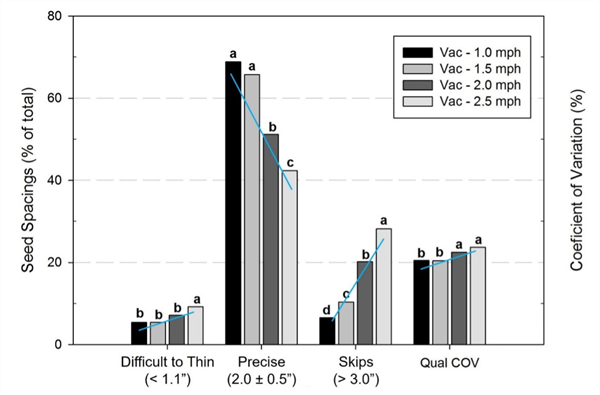It’s October and planting season is well underway. When planting lettuce, uniform seed spacing is critical for efficient, economical crop thinning. Due to their lack of precision, automated lettuce thinning machines cannot eliminate lettuce plants that are spaced closer than about 1 1/8” apart. These closely spaced plants, commonly referred to as “doubles”, must be carefully removed by hand which is time consuming and expensive.
Several years ago, we conducted trials examining the influence of planter travel speed on seed spacing uniformity (Siemens and Gayler, 2016). In the study, two types of planters - a vacuum planter (Stanhay 785 Singulaire) and a belt planter (Stanhay 870) were tested with pelleted lettuce seed at travel speeds of 1.0, 1.5, 2.0 and 2.5 mph at the Yuma Agricultural Center. Vacuum planter test results showed that the percentage of “difficult to thin” spacings, defined seeds spaced less than 1.1” apart, increased from about 5% to 10% as speed increased from 1.0 mph to 2.5 mph (Fig. 1). Concomitantly, the percentage of seeds “precisely placed” within 0.5” of the target location (i.e., 2.0 ± 0.5”) decreased from 70% to less than 45%, and the percentage of skips increased from 7% to 30%. Variability of seed spacing uniformity as measured by the coefficient of variation (COV) of seed spacings also increased.
Similar declines in planter performance were found with the belt planter (Fig. 2). As travel speed increased from 1.0 to 2.5 mph, the percentage of difficult to thin spacings increased from 2% to 10%, precise spacings decreased from 93% to 65% and skips increased from 2% to 8%.
For both planter types, there was a significant decline in performance as speed increased from 1.5 mph to 2.0 mph, a difference in speed of only 0.5 mph. These results suggest that it is prudent to check planter performance at the chosen operating speed prior to establishing an entire block to ensure that seed spacing uniformity, not just the number of seeds per foot, is acceptable.
In short, the study showed that planter travel speed had a significant effect on seed spacing uniformity and difficult to thin, close spacings - the higher the speed, the poorer the performance.
You may be asking what is the reason for the phenomenon observed? A logical explanation is that seeds are traveling at the speed of the planter when they are released and tend to “bounce and roll” in the direction of travel when they hit the soil surface. Thus, the higher the travel speed, the further seeds bounce and roll resulting in increased seed spacing variability.
References
Siemens, M.C., & Gayler, R.R. (2016). Improving seed spacing uniformity of precision vegetable planters. Appl. Eng. Agric., 32(5), 579-587

Fig. 1. Seeding performance of a vacuum vegetable planter sowing lettuce when
operated at four travel speeds.

Fig. 2. Seeding performance of a belt vegetable planter sowing lettuce when operated at
four travel speeds





